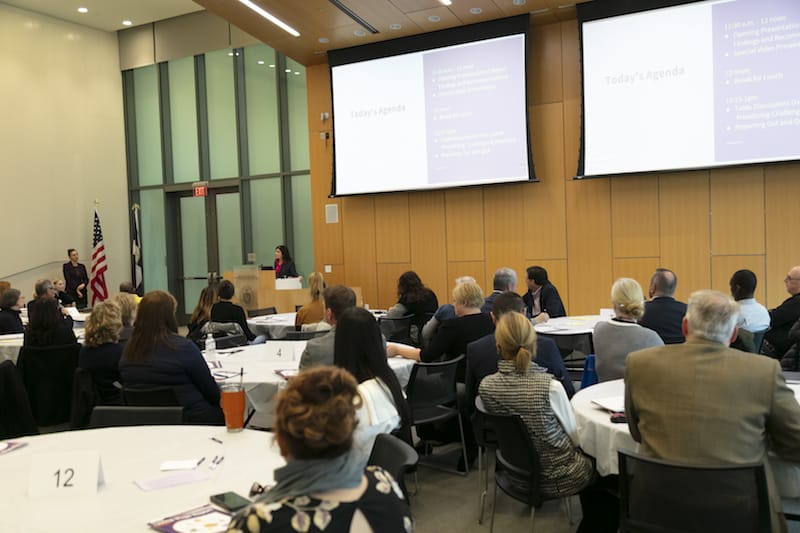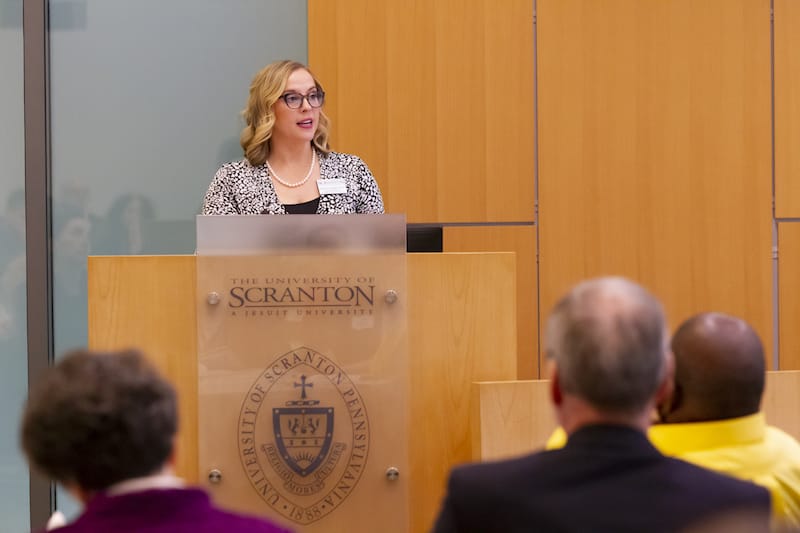Findings of 2022 Living Wage Report Presented

The “living wage income” required for a family of four in Lackawanna and Luzerne counties increased by 39 percent since 2019, according to findings of a 2022 Update of the NEPA Living Wage Report, which was presented to NEPA community leaders at The University of Scranton on Nov. 29.
The Living Wage Report for NEPA, first issued in 2016, defines a “living wage” as the wage rate at which a worker, employed on a full-time basis, can reach a standard of living that meets essential basic needs and allows the individual or family to live a modest but dignified life. The report outlines the living wage threshold for various family compositions in NEPA, such as a family of three, or a family of four. The report reflects principles of Catholic Social Teaching in regard to poverty, just wages and economic justice.
“While our region continues to make many gains and improvements, the study shows that too many of our neighbors experience economic hardship,” wrote Rev. Joseph Marina, S.J., president of The University of Scranton, in a message in the 2022 update. “I am especially struck by how the median income for both counties now falls short of a living wage for all households with children. Costs are rising for food and other essential needs, while wages and supports are not keeping up, and there is a serious shortage of affordable housing.”
The 2022 report compares current and previous data, details the increases in costs of living, explains some of the major challenges facing those who fall below the living wage threshold, and proposes solutions to address these challenges. The 2022 report highlights mitigating factors – in particular, racial disparities and the impact of the COVID-19 pandemic and related policies on economic security.
“The most recent data points to an acute need for affordable housing that calls for new policies and approaches,” said Julie Schumacher Cohen, assistant vice president for community engagement and government affairs. “The report also provides a new focus on racial disparities, with Black and Hispanic households having lower rates of homeownership and lower median incomes than white populations.”
Other key findings of the 2022 report show the continued gap between minimum wage and living wage; the poverty rate in Lackawanna and Luzerne counties remains high and the need for services has increased; and costs for basic needs continue to rise.
“The study found the living wage amounts have increased across the board. It’s taking more funds for families to thrive in 2022 than in the previous 2016 and 2019 reports. Rising prices of food and housing are key factors driving this trend, with rental prices having increased significantly since the start of the pandemic,” said Andrew Chew, director of research at The Institute (formerly named the Institute for Public Policy and Economic Development).
The 2022 update shows the living wage income for a family of two adults (one working) and two children in Lackawanna and Luzerne counties increased from $42,910 in 2019 to $59,717 in 2022 – a significant 39 percent increase.
“The findings of this year’s Living Wage Report emphasize the importance of continued community and government action to ensure that individuals and families in NEPA are able to live a modest but dignified life,” said JoyAnna Hopper, Ph.D., assistant professor of political science and co-director of the University’s Center for Ethics and Excellence in Public Service, in her remarks.
To achieve greater economic security for families in NEPA, the report recommends a multi-pronged approach is required that involves public policy changes, economic and workforce development efforts, government programs and private charitable activities.
Recommendations presented in the report include, expanding support for housing assistance and housing affordability; promoting practices to foster equity and inclusivity; advocating for increased wages; supporting cash assistance for low-income families and expanding food and basic necessities assistance; expanding access to existing social safety net programs and supporting programs and policies that help workers to obtain and keep jobs with family-sustaining wages.
The 2022 Update to the Living Wage Report is a project of The Institute and The University of Scranton. The full report is available on the University’s Living Wage webpage.














